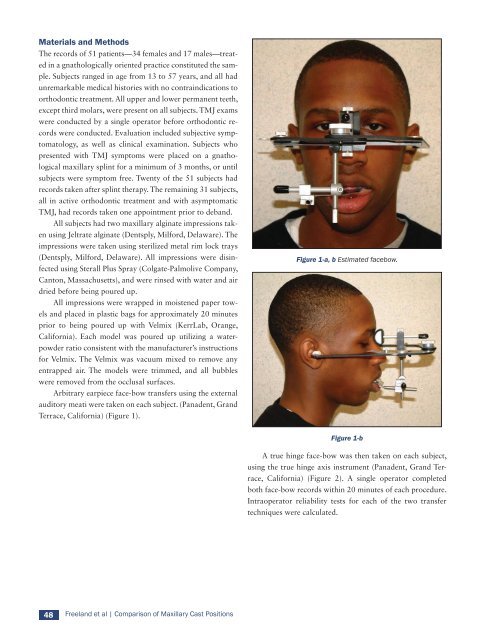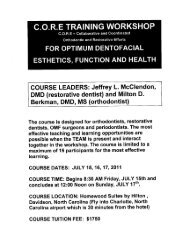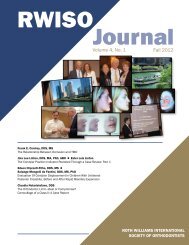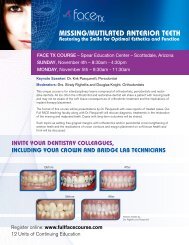2010 RWISO Journal - Roth Williams International Society of ...
2010 RWISO Journal - Roth Williams International Society of ...
2010 RWISO Journal - Roth Williams International Society of ...
You also want an ePaper? Increase the reach of your titles
YUMPU automatically turns print PDFs into web optimized ePapers that Google loves.
Materials and Methods<br />
The records <strong>of</strong> 51 patients—34 females and 17 males—treated<br />
in a gnathologically oriented practice constituted the sample.<br />
Subjects ranged in age from 13 to 57 years, and all had<br />
unremarkable medical histories with no contraindications to<br />
orthodontic treatment. All upper and lower permanent teeth,<br />
except third molars, were present on all subjects. TMJ exams<br />
were conducted by a single operator before orthodontic records<br />
were conducted. Evaluation included subjective symptomatology,<br />
as well as clinical examination. Subjects who<br />
presented with TMJ symptoms were placed on a gnathological<br />
maxillary splint for a minimum <strong>of</strong> 3 months, or until<br />
subjects were symptom free. Twenty <strong>of</strong> the 51 subjects had<br />
records taken after splint therapy. The remaining 31 subjects,<br />
all in active orthodontic treatment and with asymptomatic<br />
TMJ, had records taken one appointment prior to deband.<br />
All subjects had two maxillary alginate impressions taken<br />
using Jeltrate alginate (Dentsply, Milford, Delaware). The<br />
impressions were taken using sterilized metal rim lock trays<br />
(Dentsply, Milford, Delaware). All impressions were disinfected<br />
using Sterall Plus Spray (Colgate-Palmolive Company,<br />
Canton, Massachusetts), and were rinsed with water and air<br />
dried before being poured up.<br />
All impressions were wrapped in moistened paper towels<br />
and placed in plastic bags for approximately 20 minutes<br />
prior to being poured up with Velmix (KerrLab, Orange,<br />
California). Each model was poured up utilizing a waterpowder<br />
ratio consistent with the manufacturer’s instructions<br />
for Velmix. The Velmix was vacuum mixed to remove any<br />
entrapped air. The models were trimmed, and all bubbles<br />
were removed from the occlusal surfaces.<br />
Arbitrary earpiece face-bow transfers using the external<br />
auditory meati were taken on each subject. (Panadent, Grand<br />
Terrace, California) (Figure 1).<br />
48 Freeland et al | Comparison <strong>of</strong> Maxillary Cast Positions<br />
Figure 1-a, b Estimated facebow.<br />
Figure 1-b<br />
A true hinge face-bow was then taken on each subject,<br />
using the true hinge axis instrument (Panadent, Grand Ter-<br />
race, California) (Figure 2). A single operator completed<br />
both face-bow records within 20 minutes <strong>of</strong> each procedure.<br />
Intraoperator reliability tests for each <strong>of</strong> the two transfer<br />
techniques were calculated.








